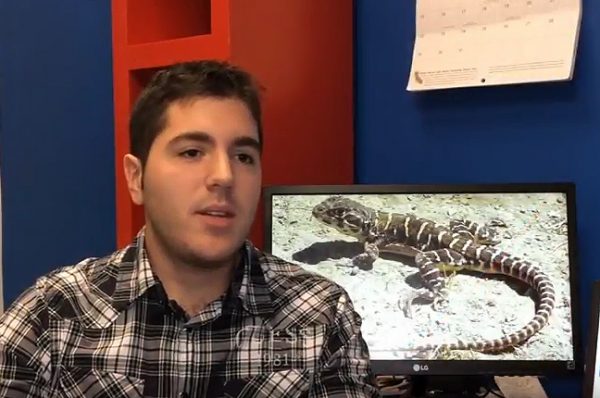Scat sniffer dogs tell York U researchers a lot about endangered lizards
TORONTO, January 31, 2017 – Dogs can be trained to find almost anything (people, drugs, weapons, poached ivory) but one York University researcher had them detect something a little unusual – the scat of endangered blunt-nosed leopard lizards. The scat detection dogs helped biology PhD student Alex Filazzola discover not only scat, but the importance of shrubs in preserving lizard populations in the face of climate change.
“The loss of these lizards would likely have a cascade effect on other species,” said Filazzola, the study lead.
The research team geotagged 700 Ephedra californica shrubs in a 32.3-hectare area of the Panoche Hills Management Area in San Joaquin Valley, California. They then took two scat detection dogs from Working Dogs for Conservation on the hunt for lizard scat in 2013 and 2014.
In 2014, there was a drought during which time lizard scat was found more frequently under shrubs, especially those with dense canopy cover, than out in the open. The shrubs proved instrumental in providing critical micro-environments for the blunt-nosed leopard lizards, in particular, shady places to regulate their body temperature in extreme heat, as well as refuge from predators. The lizards use rodent burrows, most often found under shrubs, to escape predators.
“As the climate warms and lizards find it more difficult to regulate their body temperatures in the heat, these findings could help preserve them not only in California, but globally,” said Filazzola of York U’s Faculty of Science. “It demonstrates how much animals rely on plants for survival that goes beyond that of simply eating them. Positive plant-animal interactions could further support animal populations that are already threatened.”
The research, "Non-trophic interactions in deserts: Facilitation, interference, and an endangered lizard species," was publish in the journal Basic and Applied Ecology.

Alex Filazzola of York University's Faculty of Science explains his research on lizards and climate change
Once abundant in the San Joaquin Valley, agriculture and industrialization has reduced the lizards’ range by close to 85 per cent. Predictions of increased drought in the area put the lizards at a high risk of being wiped out. The study also pointed out that management techniques used over the past 50 years have done little to change the endangered status of the lizards.
“Planting shrubs, such as the Ephedra californica, could prove critical in managing and preserving endangered species in high-stress or arid ecosystems, such as a desert,” said Filazzola. “Continuing to remove these shrubs to install solar panels, however, further endangers this species.”
In addition, the study found that invasive grasses in the desert were not beneficial. They interfered with the lizards’ ability to move around and limited available habitat by reducing the variety of rodent species which create burrows. The invasive grasses also competed for space with shrubs and caused diminished shrub growth. Managing invasive plant species is therefore crucial in these ecosystems.
The research was funded by the Central Coast Field Office of the Bureau of Land Management, Department of the Interior, a Discovery Grant from the Natural Sciences and Engineering Research Council of Canada and York University.
York University is known for championing new ways of thinking that drive teaching and research excellence. Our students receive the education they need to create big ideas that make an impact on the world. Meaningful and sometimes unexpected careers result from cross-discipline programming, innovative course design and diverse experiential learning opportunities. York students and graduates push limits, achieve goals and find solutions to the world’s most pressing social challenges, empowered by a strong community that opens minds. York U is an internationally recognized research university – our 11 faculties and 26 research centres have partnerships with 200+ leading universities worldwide. Located in Toronto, York is the third largest university in Canada, with a strong community of 53,000 students, 7,000 faculty and administrative staff, and more than 295,000 alumni. York U's fully bilingual Glendon campus is home to Southern Ontario's Centre of Excellence for French Language and Bilingual Postsecondary Education.
Media Contact:
Sandra McLean, York University Media Relations, 416-736-2100 ext. 22097, sandramc@yorku.ca






